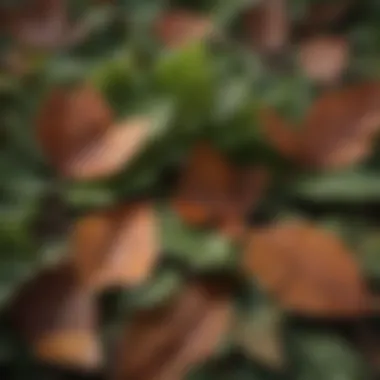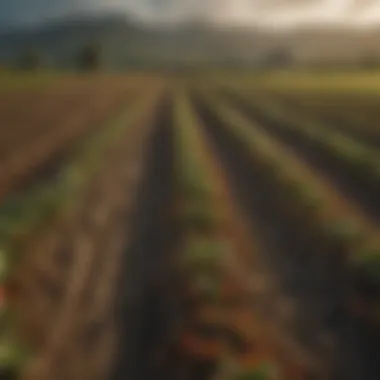Exploring Poe Annua: Its Impact on Agriculture


Intro
Poe Annua, widely recognized as annual bluegrass, holds a significant position within the agricultural landscape. This species is favored for its resilience and adaptability, serving not only as a key player in turf environments but also influencing various horticultural practices. Understanding its characteristics, management needs, and ecological impacts is essential for professionals in agriculture and those involved in related fields. This exploration aims to equip readers with valuable insights into Poe Annua’s cultivation and sustainable practices, ensuring optimum use.
Topic Overview
Definition and Importance
Poe Annua, known scientifically as Poa annua, is a turfgrass species that thrives in a range of climatic conditions. It is valued for its ability to establish quickly and its bright green appearance, making it an appealing choice for lawns, golf courses, and sports fields. Its importance extends beyond aesthetics; proper management of Poe Annua can lead to enhanced soil health, improved water retention, and reduced erosion.
Brief History and Evolution
Historically, Poe Annua has been utilized since the cultivation of grass for recreational areas began. Originally native to Europe and Asia, it spread to various regions worldwide, adapting to local conditions. Today's cultivation reflects centuries of development, with agronomists selectively breeding for traits that include drought resistance and disease tolerance. This evolutionary journey underscores its relevance in modern agriculture.
Key Techniques and Innovations
Sustainable Farming Practices
Utilizing sustainable practices in managing Poe Annua ensures its longevity and efficacy. Key techniques include:
- Integrated Pest Management (IPM): This approach minimizes chemical use by integrating biological control methods.
- Nutrient Management: Implementing soil testing and tailored fertilization increases nutrient efficiency and reduces environmental impact.
- Water Conservation: Employing methods such as drip irrigation can dramatically decrease water usage without compromising grass health.
Advanced Agronomic Technologies
Technology plays a vital role in the advancement of Poe Annua cultivation. Some contemporary innovations include:
- Precision Agriculture: Utilizing GPS and remote sensing to monitor field variability for more efficient management.
- Genetic Engineering: Research into genetically modified strains of Poe Annua aims to enhance traits such as drought tolerance and disease resistance.
- Drones and Imaging: Drones equipped with imaging technology can assess grass health and identify problem areas swiftly.
Practical Applications
Step-by-Step Guides
How to establish Poe Annua:
- Site Selection: Choose a well-drained area with adequate sunlight.
- Soil Preparation: Test the pH and amend as necessary to create optimal growing conditions.
- Seeding: Utilize a seed drill or broadcast method, ensuring even coverage.
- Watering: Keep soil consistently moist until establishment.
- Mowing: Once established, regular mowing helps maintain optimal height and promotes denser growth.
Case Studies or Real-World Examples
Exploring agricultural applications of Poe Annua, several case studies highlight its effectiveness:
- A golf course in Florida adopted Poe Annua as a primary turfgrass, achieving remarkable green cover while minimizing maintenance costs through sustainable practices.
- In urban landscaping, Poe Annua has been successfully used in parks, offering a lush appearance with lower water needs compared to traditional turf species.
"The adaptability of Poe Annua to various environmental conditions makes it a top choice for turf applications across the globe."
Understanding the various aspects of Poe Annua equips agricultural professionals and enthusiasts alike with knowledge for improved practices and sustainability in both agricultural and horticultural domains.
Preamble to Poe Annua
Poe Annua, also known as annual bluegrass, holds a critical position in agricultural practices, particularly in turf management. Its significance extends beyond aesthetics; it influences soil health, crop yields, and ecosystem dynamics. In this article, we will explore the various aspects of Poe Annua, from its defining characteristics to its historical relevance. Understanding Poe Annua is essential for those in agriculture, horticulture, and turf management, as it provides insights into effective cultivation and management strategies.
Defining Poe Annua
Poe Annua is recognized as a perennial grass species that thrives in cool, temperate climates. Its growth habit is unique due to its ability to germinate and establish itself quickly, making it a popular choice in many regions. Annual bluegrass is typically characterized by its vibrant green color and fine-textured blades, often forming dense mats. This grass is not just a landscaping choice; it plays a vital role in various agricultural applications, including golf courses, parks, and lawns.
Poe Annua can tolerate diverse soil types but prefers well-drained, moist environments. This adaptability ensures its prevalence in varying conditions, though it may face challenges in hotter climates.
Historical Significance
The historical roots of Poe Annua can be traced back to Europe and Asia, where it was initially recognized for its resilience and rapid growth. Over time, it has been introduced to different parts of the world, primarily as a turfgrass in recreational and agricultural settings. The grass became a mainstay in sports fields and golf courses due to its aesthetic appeal and durability under foot traffic.
Poe Annua has also been historically significant in research settings, providing insights into grass genetics and adaptation mechanisms. Its adaptability to various environmental conditions has prompted studies that inform agricultural practices and biodiversity conservation. Understanding its historical significance offers valuable context for contemporary agricultural strategies, highlighting its role as a staple species.


"Poe Annua is more than just grass; it is a foundational element in sustainable agriculture and turf management that has evolved over centuries."
This exploration of Poe Annua illustrates its vital contributions to agriculture and emphasizes the importance of informed management practices to leverage its benefits effectively.
Botanical Characteristics
Understanding the botanical characteristics of Poe Annua is key to appreciating its role in agriculture. These traits influence how the plant interacts with its environment and how effectively it can be cultivated and managed. From the overall morphology to its physiological responses, each aspect plays a significant role in its adaptability and usability. In this section, we will explore these characteristics in detail, revealing their importance for successful farming practices.
Morphological Traits
Morphological traits of Poe Annua encompass its physical form, including leaf structure, root system, and growth habit. The leaves are typically fine, elongated, and have a vibrant green color. This fine leaf texture contributes to a dense lawn appearance. Such traits make Poe Annua desirable for both aesthetic landscapes and functional turf applications.
The root system, however, is shallow compared to other grasses. This means nutrient and water absorption occurs mainly in the topsoil, which can be beneficial in certain cultivation scenarios. However, this especially makes it susceptible to drought conditions. Understanding these traits can help farmers to devise appropriate management practices, ensuring adequate watering and feeding.
Another notable trait is its reproductive strategy. Poe Annua spreads through seeds and vegetative means, which supports rapid population growth. Farmers can leverage this characteristic by sowing seeds at appropriate times to establish robust turf or to compete with weeds effectively.
Physiological Adaptations
Poe Annua exhibits remarkable physiological adaptations that enhance its survival in varied conditions. One crucial adaptation lies in its ability to grow under cooler temperatures, making it suitable for cooler climates or transitional zones. This quality allows it to serve as a reliable turfgrass option during seasons when warm-season grasses are less active.
Furthermore, Poe Annua displays a notable tolerance to shade. This adaptability enables it to thrive in environments with partial sun exposure, which is common in many urban landscapes. However, while it can tolerate shaded areas, light levels significantly influence its growth rate and quality. Farmers should consider this when selecting sites for cultivation.
Another important physiological characteristic involves its response to stress. Poe Annua can enter dormancy during periods of environmental stress, like drought or high temperatures. During dormancy, it conserves resources, allowing it to bounce back when favorable conditions return. Recognizing this capability assists farmers in managing expectations during season changes, ensuring they maintain ideal conditions for recovery.
"Understanding the botanical characteristics of Poe Annua can significantly enhance management strategies and improve agricultural outcomes."
In summary, the morphological and physiological adaptations of Poe Annua profoundly affect its agricultural utility. By comprehending these traits, farmers can improve cultivation methods and maintenance practices, achieving a successful turfgrass management strategy.
Growth Habits
Understanding the growth habits of Poe Annua, commonly known as annual bluegrass, is essential for optimizing its use in both agricultural and turf management contexts. This section examines specific elements influencing the plant's growth, including optimal environmental conditions and its response to seasonal changes. Knowing these aspects can lead to better management decisions and improved outcomes.
Optimal Conditions for Growth
Poe Annua thrives under certain conditions that support its growth requirements. These conditions include soil type, moisture levels, and temperature ranges.
1. Soil Type:
Annual bluegrass prefers well-drained soils with a pH around 6.0 to 7.0. It grows well in sandy loam but can adapt to various soil textures. Proper soil aeration is crucial for root health.
2. Moisture Levels:
This plant species requires consistent moisture but is sensitive to waterlogging. A balance must be struck to ensure adequate hydration without causing root rot. Irrigation practices must align with rainfall patterns to maintain soil moisture throughout its growth cycle.
3. Temperature Ranges:
Poe Annua is a cool-season grass. It thrives in temperatures between 60°F and 75°F. Extreme heat can cause stress, leading to dormancy, while too low temperatures may impede growth.
4. Light Exposure:
Full sun to partial shade is ideal for its growth. It can tolerate some shade but will not perform optimally under dense canopy coverage.
The interplay of these conditions affects the overall growth, influencing factors such as vigor, disease resistance, and competitive abilities against other species.
Seasonal Growth Patterns
Poe Annua's growth is significantly influenced by seasonal changes. Understanding its growth patterns throughout the year provides insight into effective management practices.
Spring Growth:
As temperatures rise, annual bluegrass resumes growth rapidly. Its metabolism increases, promoting lush foliage. This is often an ideal time for fertilization, providing nutrients that enhance growth during the active season.
Summer Dormancy:
In hotter temperatures, Poe Annua may enter a state of dormancy. Its growth slows down, and it may turn brown. This response is a survival mechanism under stress.
Autumn Recovery:
With relief from heat, Poe Annua reawakens and resumes its growth cycle. This period is important for recovery and helps replenish energy stores in preparation for winter. Fertilization in this season supports root growth, setting the stage for the next year.
Winter Dormancy:
During colder months, the grass becomes dormant and needs little water or nutrients. Proper winter preparation, such as aeration and reducing compaction, can improve spring recovery.
Understanding these growth habits is crucial for agricultural professionals and enthusiasts. By aligning management practices with the natural growth patterns of Poe Annua, better results in turf quality and agricultural applications can be achieved.
Poe Annua in Turf Management
Poe Annua, commonly known as annual bluegrass, plays a crucial role in turf management, especially in cooler climates. It is renowned for its ability to thrive in a variety of conditions, making it popular for both sports fields and recreational areas. This section will explore its applications and essential maintenance requirements.


Uses in Sports and Recreation
Poe Annua serves as a foundational grass species in many athletic and recreational settings. Its fine texture and lush appearance enhance the visual appeal of sports fields, golf courses, and parks. Key uses include:
- Golf Courses: The grass is highly valued for putting greens because of its smooth surface and rapid recovery from foot traffic.
- Sports Fields: Soccer, football, and baseball fields benefit from its tolerance to wear and ability to grow in partial shade, contributing to durable playing surfaces.
- Parks and Recreation Areas: Its minimal maintenance needs make it a cost-effective choice for public parks where aesthetic appeal is desired without extensive care.
Poe Annua's capacity to germinate quickly allows for rapid establishment and repair, crucial for facilities requiring consistent game quality.
Maintenance Requirements
The success of Poe Annua in turf management is closely linked to specific maintenance practices. These ensure that it remains healthy and vibrant. Effective management includes:
- Mowing: Regular mowing is essential. Cutting height impacts the grass’s health and thickness, typically ranging from 1 to 2 inches for optimal growth.
- Fertilization: Balanced fertilization supports nutrient availability, especially during the growing season. A soil test can guide the right type and timing of nutrients.
- Watering: Adequate irrigation is vital, particularly during dry periods. Watering should be deep and infrequent to encourage deep root development.
- Aeration: Soil compaction can hinder growth. Aerating the turf alleviates compaction, promoting water infiltration and root expansion.
"The approach to maintaining Poe Annua turf is pivotal for its longevity and performance in various settings. Proper practices make a significant difference in its resilience and visual appeal."
In summary, understanding the uses and precise maintenance required for Poe Annua is essential for effective turf management. Whether on golf courses or sports fields, this grass species is an invaluable asset, provided that its needs are recognized and addressed. Proper attention can lead to lush, green environments that serve both functional and aesthetic purposes.
Ecological Importance
Poe Annua, widely known as annual bluegrass, plays a crucial role in maintaining ecological balance, particularly in agricultural settings. Understanding its ecological importance can help farmers and enthusiasts appreciate its multifaceted benefits. In this section, we will explore the specific elements that underscore the value of Poe Annua in promoting biodiversity and enhancing soil health.
Role in Biodiversity
Poe Annua contributes significantly to biodiversity. It serves as a habitat for various small organisms and insects, supporting the food web in agricultural ecosystems. The grass provides cover and sustenance, offering refuge for pollinators and other beneficial insects.
- Supports Native Species: When woven into the landscape, it supports traditional flora and fauna. Many birds and insects depend on the ecosystems where Poe Annua thrives.
- Promotes Genetic Diversity: As a naturally resilient species, Poe Annua can adapt to varied conditions. This adaptability contributes to genetic diversity, ensuring more robust ecosystems.
- Facilitates Plant Interactions: The presence of Poe Annua can lead to interactions with other plants, aiding in the establishment of a balanced ecosystem. This interaction is essential for preventing the dominance of harmful species.
"Maintaining biodiversity through plants like Poe Annua is key for sustainable agriculture."
Impact on Soil Health
The soil health serves as the foundation for successful agricultural practices. Poe Annua plays an important role in maintaining and improving soil conditions, crucial for crop productivity.
- Soil Structure Improvement: The roots of Poe Annua help bind soil particles, promoting better structure. This binding enhances aeration and water retention, leading to healthier crops.
- Nutrient Cycling: The growth of Poe Annua contributes to nutrient cycling. As it dies back, its organic matter contributes to the soil’s nutrient pool, supporting subsequent crops.
- Weed Suppression: By establishing a dense canopy, Poe Annua can suppress the growth of unwanted weeds through competition. This natural property reduces the need for chemical herbicides, promoting a more eco-friendly approach to farming.
Incorporating Poe Annua into agricultural systems not only benefits the environment but also boosts productivity and sustainability. Understanding these ecological benefits is paramount for farmers aiming to implement more effective farming techniques. The advantages extend beyond simple cultivation and into the realms of ecological conservation.
Challenges in Cultivation
Cultivating Poe Annua presents several challenges that impact its viability as a turfgrass species. Understanding these challenges is fundamental for farmers and enthusiasts aiming to maintain healthy and productive crops. This section will explore the key challenges involved in the cultivation of annual bluegrass, particularly in terms of pest and disease management, as well as the environmental stressors that can hinder growth and sustainability.
Pests and Diseases
Pests and diseases are the most urgent challenges for Poe Annua cultivators. The presence of various insect pests can cause substantial damage to annual bluegrass. For instance, the bluegrass billbug and grub worms are common pests that feed on the roots and shoots of the grass, leading to significant turf deterioration.
Furthermore, Poe Annua is susceptible to several diseases, such as dollar spot, powdery mildew, and anthracnose. These diseases thrive in humid conditions, making them particularly troublesome during the warmer months or in regions with high humidity.
To mitigate these challenges, integrated pest management strategies are essential. This includes:
- Monitoring grass for pest activity and disease symptoms.
- Implementing cultural practices such as proper mowing heights and adequate fertility.
- Utilizing biological controls when feasible, like introducing beneficial insects.
Maintaining healthy soil can also aid in preventing diseases by ensuring that the grass has the nutrients it needs to fend off infections more effectively.
Environmental Stressors
Environmental stressors can further complicate the cultivation of Poe Annua. Factors such as extreme temperatures, prolonged drought, and excessive rainfall can adversely affect its growth. Poe Annua prefers a temperate climate, and any deviation from its ideal growth conditions can lead to suboptimal performance.
For instance, during the summer months, high temperatures may drive the grass into dormancy. This can frustrate those who depend on annual bluegrass for aesthetic or recreational purposes, leading to uneven turf. Conversely, cold temperatures might promote slow growth or even winter kill in susceptible varieties.
Additionally, water management practices are crucial. An excess of water can lead to root rot and other fungal diseases, while insufficient water will stress the plant.
To address these environmental challenges, growers should:


- Implement effective irrigation techniques for consistency in water supply.
- Select drought-tolerant varieties of Poe Annua when applicable.
- Apply mulch or organic materials to conserve soil moisture.
Effective management of both pests and environmental stressors is not just about maintaining the health of Poe Annua; it is about ensuring the sustainability of agrarian practices as a whole.
Understanding these cultivation challenges is essential for anyone engaged in agricultural practices involving Poe Annua. Addressing these factors actively can lead to better outcomes in terms of turf quality and overall sustainability.
Sustainable Practices for Poe Annua
Sustainable practices for Poe Annua not only enhance its growth and resilience but also contribute to the overall health of ecosystems. Implementing such methods helps manage the grass effectively while reducing environmental impacts. Emphasizing sustainability ensures that Poe Annua remains a viable choice for both agricultural and recreational areas.
Integrated Pest Management
Integrated Pest Management (IPM) is a crucial approach in the cultivation of Poe Annua. This method combines various strategies to minimize pest damage while promoting environmental health.
- Monitoring: Regularly check for pests and diseases. This allows for timely identification, which is vital for effective control measures.
- Biological Control: Utilize natural predators to keep pest populations in check. For instance, introducing beneficial insects can help combat harmful pests.
- Cultural Practices: Maintain healthy turf through proper mowing, watering, and fertilizing. This enhances the overall vitality of the grass, making it less susceptible to pest problems.
- Chemical Control: When necessary, selectively apply pesticides that have minimal impact on non-target organisms. Always follow recommended guidelines to ensure safety.
Adopting IPM can significantly reduce reliance on chemical pesticides, benefitting both Poe Annua ecosystems and users.
Water Conservation Techniques
Water conservation is essential for sustainable Poe Annua cultivation, especially in regions facing water scarcity. Implementing effective strategies can ensure that this grass thrives without excessive water usage.
- Irrigation Management: Implementing drip irrigation or soaker hoses can minimize water loss. These systems deliver water directly to the base of the grass, reducing evaporation.
- Soil Moisture Monitoring: Using moisture sensors can help determine when irrigation is genuinely needed. This avoids overwatering, leading to healthier turf.
- Drought-Tolerant Varieties: Selecting Poe Annua strains with increased drought resistance can significantly lower water requirements.
- Mulching: Applying organic mulch around the turf allows for enhanced moisture retention while suppressing weeds.
These water conservation techniques help maintain the integrity of Poe Annua while contributing positively to the environment.
Future Perspectives
The future of Poe Annua, or annual bluegrass, in agriculture appears both promising and complex. Understanding future perspectives for this plant is essential for farmers and agricultural enthusiasts. This section assesses the evolving trends in research, climate impacts, and their implications for effective use.
Research Trends
In recent years, the study of Poe Annua has increased significantly. Researchers focus on various areas, including genetics, pest resistance, and adaptability to changing climates. Advancements in genomic studies allow scientists to unlooe the genetic makeup of Poe Annua. This knowledge can lead to the development of more resilient strains that thrive in diverse environmental conditions.
- Genetic modifications are being tested to improve growth rates and disease resistance.
- Studies on hybrid varieties aim to create turfgrasses that require less water and fewer resources, addressing sustainability.
- Ongoing research investigates ecosystem services provided by Poe Annua, such as nutrient cycling and soil stabilization.
These research trends emphasize the need for collaboration among scientists, farmers, and industry stakeholders. By sharing knowledge, they can create practical applications that benefit both agriculture and the environment.
Changing Climate Impacts
Climate change poses significant challenges to agriculture, and Poe Annua is no exception. As temperatures rise and weather patterns shift, understanding how these changes affect Poe Annua becomes critical. It remains crucial to analyze its performance under these new conditions to ensure sustainable use.
- Temperature variations influence growth cycles and flowering times. Higher temperatures may cause earlier blooming, affecting management practices.
- Changes in precipitation patterns increase the risk of drought or flooding, demanding adaptability in cultivation methods.
- The spread of pests and diseases may increase as warmer climates allow certain species to thrive, necessitating strong pest management strategies.
"Adapting Poe Annua cultivation practices to changing climates is not just about survival; it's about enhancing resilience in the face of uncertainty."
Farmers must stay informed about climate trends and tailor their management practices adequately. This responsiveness will help maintain the viability of Poe Annua as a reliable turfgrass choice.
Epilogue
In summation, the examination of Poe Annua offers a multidimensional understanding of its role in agriculture and turf management. Annual bluegrass is not just a turfgrass; it stands as a crucial species entwined with various agricultural practices. It presents numerous attributes favorable for diverse climates and uses, from enhancing landscapes to providing dependable ground cover in high-traffic areas.
Concluding this exploration, several key insights emerge. Poe Annua’s resilience allows it to thrive under a variety of conditions. This adaptability is essential for farmers and turf managers aiming for sustainable practices. The ecological functions it supports, such as soil stabilization and contribution to biodiversity, are also noteworthy benefits.
Moreover, the challenges surrounding its cultivation, such as susceptibility to pests and diseases, highlight the need for effective management strategies. Understanding these aspects can lead to improved agricultural practices that benefit growers and the environment alike.
Summation of Key Insights
- Versatility: Poe Annua adapts well to numerous environments, making it a common choice in both agricultural and urban settings.
- Ecological Benefits: It supports biodiversity and enhances soil health, which can contribute to overall ecosystem well-being.
- Cultivation Challenges: Awareness of pests and diseases is vital for ensuring productive growth and management.
- Sustainable Practices: Implementing integrated pest management and water conservation techniques is critical as we move towards more resilient agricultural futures.
Call to Action for Further Research
As the dynamics of climate change evolve, further research is crucial to unlock more about Poe Annua's potential and limitations.
- Explore Genetic Variability: Investigating the genetic diversity of Poe Annua might reveal more resilient strains that can withstand environmental stressors.
- Study Sustainable Management Practices: Ongoing research into sustainable practices will support effective use while minimizing negative impacts on ecosystems.
- Impact of Climate Change: Understanding how changing climatic conditions will affect its growth and adaptability is essential for future agricultural planning.
Therefore, an ongoing dialogue among agricultural scientists, practitioners, and students is essential. This dialogue can facilitate shared knowledge and innovative solutions to optimize the use of this important turfgrass.
Continued investment in research and education will ultimately lead to advancements in agricultural practices that leverage the strengths of Poe Annua.



